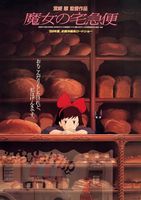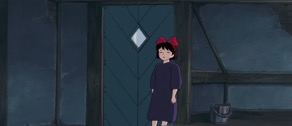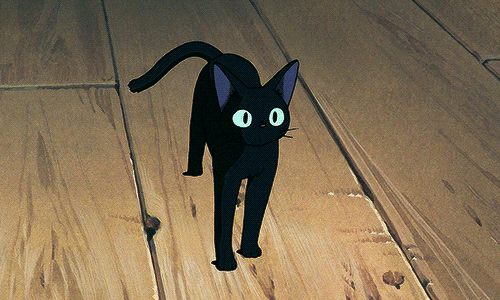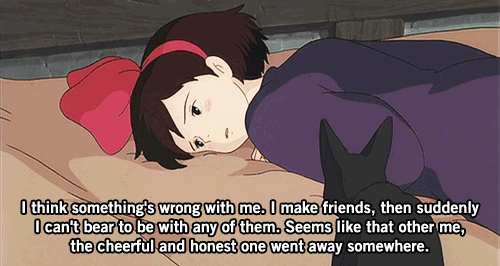
In Kiki’s Delivery Service one of the representations of animals is Kiki’s cat and familiar, Jiji. A familiar is a supernatural entity that can aid a witch with her magic, often in the form of an animal, and in this film Kiki, the young witch, can communicate with Jiji, an adult male cat, but no one else appears to understand him. This post will look at the loss of her ability to communicate with Jiji that occurs towards the end of the film around 1:14:25 and how this depiction of human animal relationships functions as an allegory for puberty.
In this scene Kiki arrives back in her room directly after leaving Tombo and his friends. She feels as if she cannot compete with other girls her age and older, who have such ‘pretty dresses’ while she wears all black, believing she’s ‘not very beautiful’.[1] Her confusion is connected to her impending maturity: this film is set on the cusp of her 13th birthday, a date traditionally marking the beginning of a child’s transition into adulthood.

She turns on her radio but almost immediately turns it back off, the burst of the radio a brief intermission of diegetic sound that emphasises the quiet of the room afterwards. The only other sounds audible are her footsteps and the distant breaking of the sea. She moves slowly, eventually collapsing face down on her bed, and the film cuts to a long shot of the dark room, which is motionless for a few seconds, the only light source emanating from the window. The pause means the audience has time to focus on the window, as the point where Jiji usually comes in and out of the room, because Jiji’s presence is usually illuminating in some way: as Kiki’s familiar, he is her closest confidante. He also provides humour throughout the film, as an occasionally cowardly and frequently sarcastic character, who balances Kiki’s earnestness and courage. As he appears from the light source, the mise-en-scène subtly suggests to the audience that Jiji’s presence will, as usual, bring light and clarity. He hops to the ground, and the scene cuts to a close up of him approaching Kiki, a shot designed to imply that he is about to speak.

When his mouth opens, instead of shedding light on her uncertainty, he only meows, tilting his head to the side in question. He gazes at her inquisitively, but there is no way to understand what he wants. Kiki attempts to discuss her fears with Jiji as she usually would—‘Jiji, I think something’s wrong with me’—while the use of shot/reverse shot between the two implies through the tradition of cinematic expectation that communication is occurring.[2] This means that the audience is as wrong-footed as Kiki when Jiji fails to respond, and leaves mid-sentence. The quietness of the build-up to this moment is also significant, because it intensifies the lack of articulate speech coming from Jiji, adding to the sense of unease that something is wrong. It eventually becomes apparent he has returned to naturalistic animal, rather than magical intuitive creature.

The elimination of this deep and magical connection between Kiki and Jiji reflects Kiki’s emotional maturation. Animals are often used to reflect childlike behaviour in films, through their wildness, unknowability, and otherness. At the beginning of the film Jiji’s character does not represent these traits, but rather is capable of speech and humour. The audience can understand him because we watch the film from Kiki’s perspective: he isn’t othered, but an extension of Kiki, an advisory counterpoint to some of her more rash decisions. Even their names mirror each other, although Jiji is an adult male cat while she is a young woman. As she becomes an adult, however, she develops the ability to think critically on her own, and so doesn’t need an external adult presence. She is also no longer the unknowable other of the child, losing the magical connection because as an adult she has found a sense of belonging, but Jiji as an animal is still other. Initially she feels abandoned by him—‘some friend you are!’—but by the end of the film she is secure enough in herself to no longer require the magical connection with Jiji.[3] He is still her pet, and friend, but the two do not communicate with language again, a bittersweet allegory for the childlike liberation, magic, and wonder lost in transition to adulthood.
References
[1] Hayao Miyazaki, Kiki’s Delivery Service (Studio Ghibli, 1989).
[2] Ibid.
[3] Ibid.